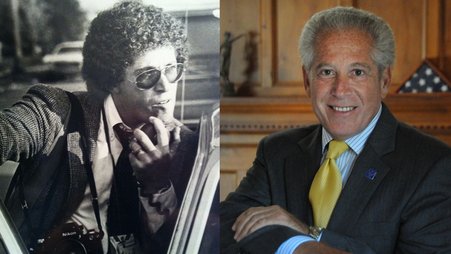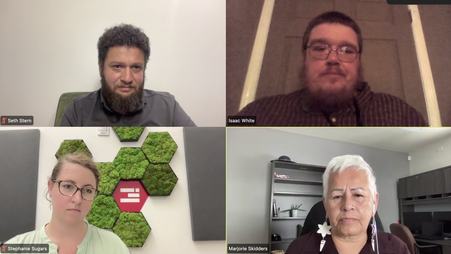People often ask us how they can help advance press freedom and push back against censorship, seizures of reporter’s equipment, and other violations. Some options include reaching out directly to lawmakers and public officials, amplifying social media content, and donating to press freedom organizations like Freedom of the Press Foundation (FPF). Those strategies make a real difference. But for people who are able to spend a little more time and have more to say, we often recommend writing newspaper op-eds or letters to the editor.
Op-eds and letters are a double-win for the free press. One, op-ed and letter writers can make their pro-press freedom points to a large audience, with the credibility of an established outlet behind them (op-eds and letters are not necessarily endorsed by the papers that print them, but it still means something that editors selected them for publication). Two, writers like you are able to contribute compelling original content to news outlets that may, like many local papers, be struggling to keep the lights on.
We thought we’d share some of the advice that we often give to people who ask us about writing op-eds and letters to the editor. (We’ll mostly discuss op-eds here but many of our suggestions apply to both). We'll cover what your op-ed can accomplish; how to get papers interested; where, how, and when to pitch your op-ed; and guidelines for writing.
What will my op-ed accomplish?
Op-eds bring attention to issues you care about — not only from the general public but from lawmakers, advocacy groups, and others who read your piece, both in the paper and through social media platforms. They’re a way to put your concerns on decision-makers’ radars and exert pressure on them to take action, while also positioning yourself as a subject matter expert, opening up further opportunities to get your views out there.
In 2022, for example, we submitted op-eds to the Chicago Sun-Times calling on Sen. Dick Durbin to support the PRESS Act — a shield bill protecting journalists from government surveillance, including through the journalists’ technology providers. We think the bill is of vital importance to press freedom. In return, Durbin wrote a letter to the editor of the Sun-Times professing his support for the act, and, in 2023, he became a co-sponsor.
Not all op-eds will achieve immediate measurable results, but they’re still valuable. We authored multiple op-eds opposing the prosecutions of journalists in Asheville, North Carolina, for violating a park curfew to cover a police eviction of a homeless encampment. Unfortunately, prosecutors proceeded anyway, but the op-eds helped bring significant attention to the case from both the press and civil society. Now, if you Google “journalists prosecuted for trespassing” or something similar, you’ll see story after story about the Asheville case. A future prosecutor considering going after journalists for doing their jobs might well see that backlash and reconsider.
Press freedom seems niche — how can I gain newspapers’ interest?
We don’t see it as a niche issue but as an overarching issue that encompasses everything else. The Fourth Estate functions as a surrogate for the public and the press shapes the national discourse about every other topic.
That said, it’s true that newspapers are sometimes reluctant to make themselves the story by writing about press freedom — and that’s exactly why op-eds on the subject are so necessary. The op-ed pages are a perfect place to address “niche” issues that newspapers might not be willing to spend their own editorial resources covering.
To increase the odds of an op-ed being published, it’s always useful to look for a “news hook” — a recent event that brings home the urgency of the underlying issue. For instance, after a recording of the police raid of the Marion County Record captured an officer hoping out loud that the seized equipment wasn’t encrypted, we wrote about the importance of encryption for modern newsrooms. It’s an issue that’s always top of mind for us at FPF, but the raid provided a unique opportunity to call it to the public’s attention.
It can also help to draw connections to items the outlet you’re targeting has previously written about — after all, you know they’re interested in those topics. If you’re writing about Florida Gov. Ron DeSantis’ anti-press antics, for example, it may be helpful to broaden the scope by touching on his more general war on free expression, which has gotten far more coverage.
There’s no strict stylistic format for op-eds — and you definitely don’t need to be a trained journalist to write one — but you can take a look at other op-eds that have been published by the paper you’re targeting. You can even look at the writing style of the paper’s editorial board. Either may give insights on that outlet’s stylistic preferences, or just general writing inspiration.
Where should I pitch my op-ed?
Depending on the topic, you might want to target the broadest audience possible (i.e., a national or major metropolitan paper), a hyperlocal outlet, or a specialty publication focused on your topic. An op-ed on the importance of reporters taking steps to avoid phishing and malware attacks, for instance, is more likely to be published by a journalism or technology-focused outlet than by a major paper covering general interest news.
We suggest being ambitious, especially if the op-ed isn’t time sensitive. Why not first pitch it to a big city newspaper if you’re looking to reach the masses, or the largest newspaper in your hometown if you’re focused on a local audience? If they don’t take it, try a smaller one, and so on. There’s no harm in requesting a response within a reasonable amount of time — say, 48 hours — and moving on if you don’t get one.
There’s no shame in running your op-ed in an outlet that wasn’t your first choice. A smaller publication can still get plenty of attention, especially with some social media legwork, like posting the op-ed (repeatedly) on your social media platforms, tagging stakeholders, and using hashtags that might attract a larger audience. And it can lead to exposure in larger outlets — our recent blog post about a subpoena to a journalist led to an interview with CNN.
How do I pitch my op-ed?
Many newspaper websites include a submission form for op-eds. You can use those if you don’t find a better option, but it’s generally not too difficult to find a staff directory and email the newspaper’s opinion editor or other editorial staff directly. The personal outreach will likely increase your odds of success, and it also gives you the option to find out if there’s interest in the op-ed before you spend your time writing it. (You may have a complete draft of your op-ed when you make your pitch, but you may also decide to pitch your op-ed before you write it.) Submission guidelines and contacts for many newspapers are listed here.
Emails pitching op-eds should be short and to the point, especially if you do decide to attach a draft. After all, the goal is for the editor to read the piece (or at least the pitch), not use up their attention span on your email. The pitch is also an opportunity to showcase your writing ability. Newspaper editors favor concise writing that gets the point across, not flowery language. A well-written pitch goes a long way in assuaging any concerns about your ability to put together an equally well-written op-ed.
An email pitching your op-ed should have one sentence introducing yourself and your professional title or qualifications (if relevant to the op-ed). It should include one to three sentences about the topic of your op-ed and why it’s newsworthy. If you have specific expertise or a personal connection to the topic, you should mention that as well. It should conclude by asking for a response within a reasonable amount of time, such as 48 hours.
Speaking of, don’t downplay your qualifications. If you write as a hobby rather than a full-time occupation, you’re still a writer. If you’re a journalism student who has published articles before, you can call yourself a journalist. You’re offering quality content, for free, and your pitch should reflect that. There’s no need to beg or apologize.
When should I pitch my op-ed?
Some op-eds are intended to spread awareness of an issue — not to prompt any specific action. Those can run anytime but, again, they’re likely to get more attention when the issue is in the news. An op-ed about the dangers of spyware for journalists, for example, might be well-timed after revelations of hacking of journalists’ devices, or news of a lawsuit against spyware developers.
Op-eds are often intended to prompt official action, so you’ll want to get them in front of decision-makers when decisions are being made. If an under-the-radar bill you support was recently introduced and you want to help it gain momentum (or you want to nip a bad one in the bud) that might be a good time to run the op-ed. Upcoming hearings or votes are also good opportunities, as are legislative recesses when lawmakers are home with their constituents.
How long should my op-ed be?
Newspapers generally accept op-eds in the 500-700 word range, whereas letters to the editor should be around 300 words, depending on the paper's guidelines.
The paper may publish its guidelines for the length of op-eds or letters to the editor. If not, you should ask the editor when they accept your op-ed pitch.
Your op-ed doesn't have to be exactly as long as the maximum word limit, but somewhere in the middle of a range or close to the maximum is fine. Don't go over the maximum word limit given by guidelines or an editor.
Are there stylistic rules for writing op-eds?
The short answer is not really — use your own voice. Op-eds don’t need to be written like news articles. You’ll obviously want to do your best to use proper grammar, but don’t stress too much — the paper has editors to clean up your punctuation and other details.
That said, here are a few basic tips. You can also find more from the OpEd Project here.
- Make your advocacy point up front — generally in the lede (or first sentence), but at least by the second sentence. You don’t want the reader to have to get through paragraphs of personal anecdotes to figure out why you’re writing.
- Connect your advocacy goal to a news hook or a relatable hypothetical so that readers understand that you’re writing about something nonacademic that really matters.
- Conclude with a specific call to action, e.g., contact your representative, attend this meeting, support this bill. And, if necessary, explain how readers can take that action.
- Don’t use too many vocabulary words. Most newspapers prefer simple and succinct writing styles, and you want readers focused on your article, not the dictionary.
- Use direct language and active verbs whenever possible.
- Edit yourself. Reread your draft and think: “Does this word add anything? Is this sentence redundant?” Once you eliminate extraneous language you’ll have space to say more within your word limit. It’s often helpful to put a draft aside and come back to it in the morning with a clear head.
What if my op-ed isn’t accepted?
It happens all the time. We pitched this op-ed about press freedom abuses by the New York Police Department to every New York news outlet we could think of, to no avail. So we published it ourselves instead. Anyone with a blog or even a social media page can do the same.
But there are other options. You could shorten the piece and submit it as a letter to the editor instead. Those are much easier to get published and, especially if promoted, still very capable of having an impact. A successful letter to the editor might also open the door to reattempting your op-ed pitch. You could also try to find a co-writer, perhaps with some name recognition, to get an editor’s attention. Or you can try again when there’s a fresh news angle that might generate more interest around your topic.
If all else fails, you still haven’t wasted your time. You’ve put your thoughts on paper and now have well-considered talking points that you can use in conversations, social media posts, and direct outreach to decision-makers.





